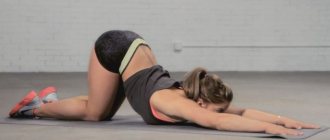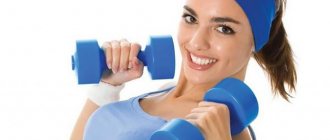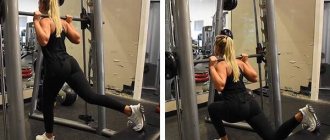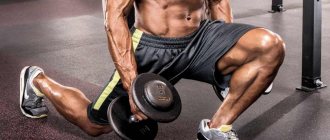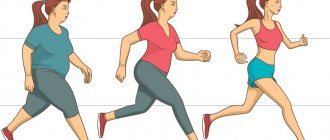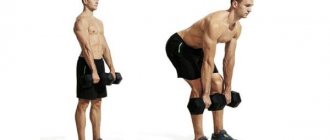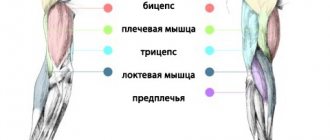Efficiency
The Butterfly expander has become the most affordable means for correcting body lines.
It is suitable for all age categories. Even people who have nothing to do with sports can use it. Regular physical training with an expander improves the lines of the body and gives the body vigor. You just need to accurately master the rules for performing various exercises.
All physical exercises with an expander are based on the principle of compression. Exercises using this method have a high level of effectiveness and make it possible to strengthen the muscles of the body in a short period of time. An expander is especially useful for the fair half of humanity, since with its help it is possible to work out the muscles of the inner thigh.
Exercises with an expander require no more than half an hour a day. You can also do shorter sessions throughout the day. They serve as an excellent addition to cardiovascular training or aerobic exercise. To increase the effectiveness of exercise, it is recommended to resort to a short warm-up before it, which will stretch and warm up the muscles.
In order for the level of effectiveness from exercising with an expander to be high, it is recommended to adhere to the following rules:
- Don't give up on the workouts you've started. Physical exercise should be done regularly. At the same time, add the degree of load evenly.
- Spend at least half an hour a day on your studies.
Walking with leg weights
Trying to walk faster, we often start walking wide. This is fundamentally wrong, as it violates the optimal natural angles in the joints of the limbs (ankles, knees, hip joints). Because of this, muscles are overextended and get tired faster, and ligaments and tendons can be stretched and injured. Look at sports walkers: they walk at the speed of a runner not due to the length of their stride, but due to its frequency!
“Like any fitness program, walking must begin with a warm-up: joint gymnastics with stretching elements,” recalls Elizaveta Karpinskaya, personal trainer at the X-Fit Fusion Premium fitness club. “Regardless of whether this activity is indoors or outdoors, you should start at a slow speed and gradually increase the pace.” If you want to walk faster, do not lengthen your stride, but move your feet more often.
Go to: ,
Human health is an undoubted blessing. To maintain it, there are a huge variety of different fitness trends, traditional and not so traditional, with and without the use of special equipment. One such sports program is the well-proven weight training.
description
Weights are special sports devices that quantitatively and qualitatively increase the load on the muscles and the effectiveness of the entire workout. Such special means take the form of cuffs that are attached to the limbs, and can be used as an alternative to exercises using dumbbells or even exercise machines. They can be used both in the gym and during outdoor training, as well as at home.
Weights are considered as a method of cardio training, with which you can keep yourself in excellent physical shape, get rid of excess weight and work on muscle definition.
Walking with leg weights
The most common workout using additional equipment is walking with leg weights. It is believed that the optional load increases calorie consumption by approximately a percentage increase in weighting, that is, if body weight due to weights increased by 5%, then energy consumption will increase by the same amount. However, it is quite difficult to accurately calculate this indicator due to the many dependent variables (type and intensity of exercise, heart rate).
Walking with leg weights
varicose veins of the lower extremities;
severe pathology of the cardiovascular and respiratory systems;
traumatic damage to muscles, joints and ligaments of the lower extremities;
vascular aneurysms;
postoperative period.
To get the maximum effect from using weights, you should not only remember the existing restrictions, but also adhere to a number of the following rules.
Monitoring the training program
The training itself should be carried out under the supervision of a competent trainer or at least after preliminary consultation with a fitness instructor. Depending on your goals and physical capabilities, he outlines a training plan and explains the technique of performing the exercises. Without observing this principle, working with weights can result in serious health problems, or a situation is possible when the volumes you don’t need will not go away, but, on the contrary, will grow.
Selection of weights
You need to choose the weights yourself wisely. To do this, you should decide on the tasks that you set for yourself - to lose weight or, conversely, to gain it. Gaining muscle mass requires heavy cuffs and strength training. Walking with leg weights for weight loss involves a little extra weight and cardio activity.
You should definitely pay attention to the material of the weighting material, the strength of fixation and ease of use.
Increased training efficiency
Exercises with weights to normalize weight are quite effective in themselves. However, to further increase their efficiency, you can resort to combined training. The effectiveness of walking with leg weights for weight loss will increase significantly if you use not only the lower limbs, but also the muscles of the arms and back.
This is possible, for example, by combining the use of weights and Nordic walking. For such training, in addition to the cuffs themselves, you will need additional technical equipment - similar Nordic walking poles. Leaning on them when walking, you can evenly distribute the load on all muscles, maintaining balance and stability.
Walking with leg weights is a great way to shape your figure, achieve your ideal weight, and increase the endurance of your heart muscle and your entire body. You just need to approach the process wisely to make the training useful and ultimately get the desired result.
Walking fast with weights on your legs
For more intense exercise, regular walking may not be enough. In such cases, walking with weights on your legs helps if you exercise correctly in accordance with your body’s capabilities. Before including such exercises in your program, you need to know which muscles work in this case and how this affects the whole body.
Advantages of weights
These workout additions can significantly improve your endurance. As a result, the functioning of the heart and lungs is stabilized, and blood flow improves. Such cuffs help strengthen the muscular system, since performing habitual actions will now require more effort.
These items are suitable for training for people who have problems with excess weight. By increasing the intensity of exercise, more calories are burned, which means that fat deposits are reduced and your figure becomes slimmer.
If you use special Scandinavian poles, moving through mountainous terrain will become more convenient. Look here https://palki-shop.ru/skandinavskie/leki-instructor-lite-cena Leki INSTRUCTOR LITE walking poles. With them, the muscles of the back and shoulder region will be involved, and the body will receive maximum training.
Who are weights suitable for?
Before choosing such equipment, you should know which muscles work when exercising with it. The muscles of the legs, buttocks, and back are most active when walking with weights. Therefore, such training is suitable for people who want to strengthen these particular muscle groups.
But if you have problems with joints, it is better to refuse additions to training. Otherwise, increased efforts will only make the situation worse. If during exercise you feel pain or discomfort, then you need to stop fast walking with weights on your legs. It is not necessary to completely stop training, you just need to reduce the load.
If you are unsure whether to use this sports equipment, consult your doctor first. It is usually not harmful if used while walking or doing simple exercise.
How to choose inventory
These types of cuffs vary in weight and application. Equipment weighing up to two kilograms is suitable for a treadmill. However, at the initial stage, preference should be given to options up to 0.5 kilograms. Gradually, when the body gets used to high voltage, you can increase the weight. As numerous reviews show, this mode reduces the likelihood of injury.
Weights are also suitable for fitness activities. Before using cuffs, you need to make sure that you can do the exercises well without them. The optimal solution is equipment with replaceable weights, which makes it possible to adjust the load. Such cuffs are called plate cuffs and are a bag with iron plates.
A replaceable version will help control the load when walking with weights on your legs. It is better to place it directly above your sneakers or sneakers. This significantly reduces the risk of injury.
Printed models have a simpler design. In this case, the fabric cuff is filled with salt or sand. Such options have a lower cost, but do not allow for load regulation.
Walking briskly with weights on your legs helps increase the load on your muscles and makes your workout more intense. When working with such equipment, you should carefully listen to your body and not overdo strenuous training.
Pros and cons of exercises with weights
Movements with weights are available to everyone, they can be performed as a warm-up complex, and after the main strength ones, it all depends on the level of the athlete. Weights can be taken with you on trips and trips; they are also a good solution for a home gym.
However, training with weights, especially in aerobic mode, has significant disadvantages:
- It is not recommended to wear weights for walking and running. Even the best of them are not attached rigidly enough and change the trajectory of movement when running and walking. This can lead to ligament strain and joint injuries, although weights are traditionally believed to help burn more calories. In fact, this “more” is comparable to the amount you would use if you walked or ran 10 minutes longer. Therefore, perhaps all these manipulations are not worth carrying out;
- You should not work in the swing amplitude. Many people take the names of exercises literally and try to “push” their legs into swings with force, which can also lead to injury to joints and ligaments. In fact, weights are a very unstable projectile and their use cannot be considered safe if it is a question of incorrect technique;
- It’s quite difficult to progress for a long time at home with weights. Let's say you increase the weight of the weights, moving from half a kilogram weights to 2 kg, then choosing the maximum weight. What's next? For most people who train regularly, such weights become insufficient after about six months of training. Then you can, of course, add the resistance of a rubber shock absorber, or you can finally go to a specially equipped room. Attempts to add resistance by performing 8-10 sets of one exercise instead of 3-4 usually only lead to increased endurance, but not strength and muscle tone. And accordingly, they do not give any visual effect;
- "frivolous character" Few people consciously control movement during the entire set of exercises with weights, which is a significant disadvantage, because this way the target muscles are not worked and “bad motor habits” are created, which then spoil the posture.
For aerobic exercise, it is better to choose not some swings, but exercises “specially adapted” for this by nature itself - running and walking. In this case, it is better to leave weights at home and wear them only for strength training.
Before “pumping your legs with weights,” you should at least do this complex:
- squatting without weights in static dynamics. Slowly lower yourself into a squat for 30 seconds and return to the starting position so that no more than 3-4 repetitions fit within the specified time interval, repeat 3 cycles, then 5 minutes of any cardio activity, such as walking on stairs or on a mini-stepper, and 2 more repeating the entire cycle;
- bending forward with weights or resistance. Take a rubber shock absorber or the same weights in your hands and perform bends in the same static-dynamic mode as in the previous exercise.
After this cycle, you can also do swings with weights:
- On the back of the thigh. Get on all fours, palms under your shoulders, knees under your hips, lower yourself onto your forearms. Now carefully move your right leg back and fix it parallel to the floor. Slowly bend your weighted leg, bringing your heel toward your buttock and consciously squeezing your hamstrings. Then return to the starting position and repeat on the other leg;
- On the gluteal muscles. Raise your straight leg back from the same starting position, making sure that your pelvis is “parallel” to the plane of the floor and does not warp relative to it. Distortions relieve stress on the buttocks;
- On the gluteal and abductor muscles of the thigh. Without changing the starting position, bend your right leg at the knee and move your thigh to the side so that the bent leg extends into a plane parallel to the floor. Slowly bring your leg back. To avoid distortion, first de-weight your working leg, pull in your stomach and tighten your back muscles, and only then perform the exercises themselves;
- On the adductor muscles of the thigh. Change your starting position, lie on the floor on your back, and move your legs perpendicular to the floor. Slowly spread and bring your legs together, trying to ensure that at the extreme point of the exercise your heels do not “fall” to the floor, but still maintain control over the movement.
Perform these exercises for 12-15 repetitions maximum, trying to keep the time under tension to no more than 40 seconds. If you can "swing" more and more actively, you have done the first part of the complex without weights incorrectly, or you probably have weights that are too small. There should be no more than 3-4 working approaches. Rest between sets is at least 45 seconds, but no more than 60 seconds.
Leg workout
It’s worth mentioning separately about legs and weights. Before starting a lesson, a thorough warm-up without leg cuffs is necessary. Exercises can be performed in the most basic ways, such as those performed in physical education lessons.
Then begins jogging with weights. Just remember that the lightest cuffs are taken first. Gradually their weight increases. It is best to do this every third workout. It is also worth increasing your running time each time. This way you will be able to tone your calf muscles. As a result of regular training, your body will become strong and toned.
The big advantage of weights is that they help maintain the amount of muscle tissue that is simply lost with age. This applies to any type of sports training. Therefore, with one hundred percent probability, weights will make any workout more effective. The muscles will become stronger and more calories will be burned.
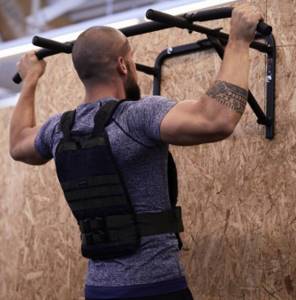
Mistake two: swinging the body
Again, in pursuit of speed, we begin to strongly “wiggle” our shoulders left and right, bending sideways at the waist. It feels like we are walking faster or at least burning more calories - after all, more movements are being made and the muscles of the back and lower back are involved. But in reality, such “swinging” only slows us down and, what is more unpleasant, puts unnecessary stress on the spine, which is forced to “squirm” from side to side.
“The torso should be kept straight with a slight tilt at the hip joints,” says Elizaveta Karpinskaya. - Feet should always be pointing forward. Be aware if painful sensations occur! Walking programs may involve gradual increases in distance and/or speed. Do not proceed to the next step if you feel discomfort."
“You should walk from heel to toe,” says Pavla Fedorova, personal trainer at the Fitlab fitness club. — The arms are bent at the elbow joints, the shoulders are relaxed and lowered, the movement of the arms is natural, in rhythm with the legs. Recommended breathing: inhale through the nose, exhale through the mouth. Inhale for 4 steps, exhale for 4 steps.”
What are the differences between running with dumbbells and regular running?
Running with dumbbells has a number of differences from other, more familiar types of running:
- When training with dumbbells while running, completely different muscles , which allow you to evenly distribute the load. In addition, burdensome objects change the center of gravity of the torso, thereby increasing it.
- Running dumbbells are able to target specific muscles such as the biceps, as well as the deltoids and trapezius muscles.
- The first two differences listed above can significantly increase the pace and load of training. These changes can also improve the functioning of internal organs, including the cardiovascular system, joints, ligaments and tendons.

You need to understand that, for example, you can run up to ten kilometers without overwork, but with dumbbells, you will be able to cover no more than three to four kilometers. Of course, the distance you can run will also depend on how resilient your body is.

This is interesting
- [uaf_vkcount url='href=»https://beginogi.ru/vitaminyi-dlya-myishts-sustavov-i-svyazok-i-kakie-vitaminyi-nuzhnyi-dlya-rosta-myishts/']
Vitamins for muscles, joints and ligaments and what vitamins are needed for muscle growth
- [uaf_vkcount url=”https://beginogi.ru/zachem-nuzhnyi-rezinki-dlya-bega-pravilnoe-primenenie/”]
Why do you need elastic bands for training? Correct Application
To ensure that running with weights does not stop after the first kilometer due to fatigue, it is necessary to follow proper breathing techniques.
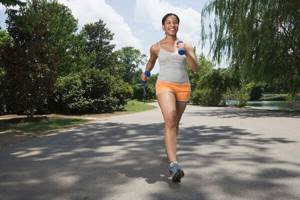
The technique is as follows:
- You need to exhale strongly every three steps. This system allows you to concentrate more on running, since it does not require special monitoring of your inhalation.
- The natural landscape is more suitable for jogging, as you can breathe much more deeply there. This will result in more oxygen entering the blood, which will also boost your metabolism and allow you to burn more fat faster.
You can choose a local park or stadium as your place to run. Running on your own gives you a lot of advantages : you can run at a time that suits you, save time and money on classes in fitness centers, etc.
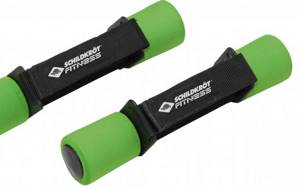
Three gluteus maximus muscles
Did you know that the gluteus maximus muscle is the largest muscle in the entire human body? Its job is to support the torso in an upright position, which is the reason for its size and power.
As the name suggests, it is the largest and closest to the surface muscle of the entire gluteal muscle group.
The function of the gluteus maximus muscle is mainly to extend the upper legs (hips) - for example, when rising from a squat position. Another example of including this muscle in work is lifting the torso tilted forward. Picture yourself swinging a kettlebell and you'll get a good idea of how this muscle works.
Hip extension also occurs during deadlifting, pushing off the legs during running and skating, and simply while swinging the leg.
This muscle is also involved in turning the leg - for clarity, imagine, for example, a duck walk.
The gluteus medius is the smallest of the gluteal muscle group, located beneath the gluteus maximus and provides stability to the hip joint, especially when standing on one leg. Thus, when walking or running (where the legs are used in turns) or climbing stairs, the gluteus medius muscle is tensed to prevent the pelvis from sinking to one side.
Moreover, the gluteus medius (and minimus) are involved in hip abduction.
It is the smallest of the gluteal muscle group, located directly below the gluteus medius. Its main function is to provide stability to the hip joint. It works together with the gluteus medius muscle.
I hope that this little anatomical excursion did not confuse you. Essentially, that's all you need to know to perform the exercises. Well, let's move on to...
Extra help when running with dumbbells
How to motivate yourself so that you don’t want to skip workouts:
- Listening to music while running. Running without your favorite songs downloaded to your player can quickly get boring. In addition, in 30 minutes of training you can listen to up to 10 songs. If you count them down, the classes may seem faster. At the beginning of each new song, you get a boost of energy for the next push. Also, the musical tempo can affect the speed of your run.
- A partner running with you. Having a girlfriend or boyfriend with you while you run can have a big impact on your motivation. Not going to training is no longer so easy (after all, you agreed with another person). There is also a certain competitive spirit .
- Aesthetic landscapes around. For running, it is better to choose a more picturesque place. This way you can enjoy nature while running, which is a huge incentive.

This is interesting
- [uaf_vkcount url='https://beginogi.ru/hodba-s-lesli-sanson-skolko-kaloriy-szhigaetsya-pri-hodbe/']
Walking with Leslie Sansone: How many calories do walking burn?
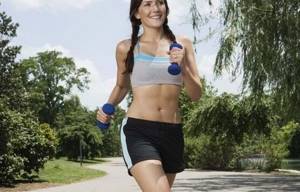
Once you finish your jogging session, you can move on to some additional exercises for your abs, thighs, and buttocks. To do this, you can use exercise machines that are installed in the park or stadium where you work out.
Advice
Once you understand why you need to run with dumbbells in your hands, you can achieve your goals, the main thing is to use the rules and listen to what your body is telling you.
Hand weights
These things are suitable for trained athletes, but not for amateurs, and especially not for beginners. Weights worn on the ankles stretch the muscles too much, and behind them the tendons and ligaments down (and they should work evenly up and down due to muscle contractions). Microtraumas form in them - anyone who has used such weights probably remembers how the muscles of the lower leg and the Achilles tendon above the heel ache the next day after training, how wooden they are afterwards! Over time, chronic injury occurs and the inflammatory process begins.
It’s the same story with weights on your arms (bracelets). In addition, excess weight on the wrists with extended muscles (when the arm is lowered) can displace the humerus in the joint, since at the top it does not rest on another bone, but only on the ligaments. “Walking poles will help increase the efficiency of energy consumption,” reminds Pavel Fedorova.
“The use of weights on the arms and legs leads to stress problems in the ankle, hip and knee joints, as well as in the lumbar region,” explains Elizaveta Karpinskaya. - Posture is impaired. It’s safer to put weights in your backpack; this additional load increases your heart rate and the number of calories burned. But the total weight of the weights should not exceed 10% of body weight.”
It’s worth noting right away that this is the most difficult method presented, and therefore you will need to try. It is advisable to have a sewing machine at home, because this will speed up the process significantly. But you can do everything with your hands.
To make your own weighting materials, you need to use the following materials:
- Four pieces of fabric. Nylon or cotton will do. The length should be 33 cm and the width 13 cm.
- The strap is 91 cm long and 2.5 cm wide.
- Rectangle or ring with dimensions 2.5 by 5 cm.
- Velcro. Many people wonder how to make Velcro at home. In this regard, I would like to say that this is not such an expensive material that you would bother too much and try to make it yourself. It’s much easier and faster to go to the first clothing accessories store you come across and buy.
- Rice or sand. You can also use any other material that will be used as a filler.
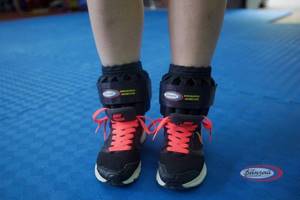
It is necessary to accurately measure two piles of filling material that will be located inside. Each section that is filled to the top will ultimately give 0.5 kg of weight. The same must be done with sand if you choose such a filler. If you want to gain more weight, then you should increase the fabric width.
How to choose
Weights are pads that are made of dense fabric, filled inside with salt, sand or other filler that makes them heavier. Sports stores will offer you a wide variety of these gizmos. Typically, the weight of weights can vary from half a kilogram to five or six. They can also be either bulk or lamellar.
What is their difference:
- Bulk weighting agents are those whose filler is the material poured into them, most often this is special sand. The downside is that they wear out quickly, and you also cannot change their weight if necessary. If you need heavy weights, you will need to buy new ones.
- But plate weights are more advanced and convenient, since the weight in them can be increased depending on how many iron plates you insert there. They are convenient for beginners to use, since thanks to the plates it is easy to set the required weight. In addition, they will save a considerable amount of money.
If you plan to exercise at home, then, in principle, half a kilogram weights will be enough for you. But if you plan to work out in the gym, then it is better to purchase plate ones, since in them you will still be able to regulate the intensity of the workout, setting exactly the weight that is necessary for certain types of exercises.
Exercises for legs and buttocks with weights.
Abdominal exercises
A. Lie down on the floor. Hands behind head. Make sure that your head is always pressed to your hands during exercises.b. Raise your head and lower your legs slightly and fix them at an angle of 45 degrees, hold in this position for 2-3 seconds. Then return to the starting position. Rest for 1-2 seconds and lift up and bend your knees slightly. Repeat the exercise 10-15 times.
Exercises for the buttocks
A. Place your hands on the floor: fingers together, elbows apart. Legs are bent at the knees. Hips should be perpendicular.b. Slowly swing your left leg back until fully straightened. Hold at the top for 2-3 seconds, then return your leg to the starting position. Do the exercise with your right leg. Keep your balance. Repeat 10–20 times with each leg.
Exercises for the back of the thighs
A. Lie on your stomach with your thighs pressed to the floor. Rest your head in your hands.b. Without bending your knees, alternately lift each leg 10 times. When you can do the exercise without much effort, increase the number of repetitions.
Exercises for the outer thighs
A. Lie on your side. Straight legs together, in line with the shoulders. Support your head with your hand. For balance, rest your other hand on the floor. b. Raise your leg to shoulder level, then slowly lower it over 2-3 seconds. Repeat the exercise 10 times, then turn to the other side and do the same with the other leg. Make sure your feet and knees are facing forward. Pull your stomach in to support your back muscles.
Exercises for the front of the thighs
A. Stand up straight. Hands on the belt, legs together. The knee of the left leg is slightly bent. Make sure that your back remains straight while performing the exercises. b. Slowly raise your left leg so that your thigh is parallel to the floor. Hold this position for 2-3 seconds, then slowly lower your leg.
Remember that when losing weight properly, it is important to use all methods in combination. If you actively engage in sports, but at the same time do not limit yourself at all in food, eat junk food at night, or indulge in sweets, there will be no effect
But there is no need to overdo it either. Meals should be complete and varied, take equal intervals between meals, and avoid snacking. Eat more vegetables and fruits. Play sports, but you don’t need to exhaust yourself with exercise, exercise should give you pleasure. This, it seems to me, is the secret of healthy, effective and proper weight loss.
Use weightbelts and the results will not keep you waiting! In our online store there is a large selection of training products: wall bars, DSK, horizontal bars, parallel bars, gymnastic rings, rubber loops, expanders, TRX loops, analog and original TRX PRO Suspension Training Kit, TRX Force Tactical, Bubnovsky tubular expanders, GD Grip, Heavy Grips and Captains of Crush wrist expanders, Finger Exerciser, finger expanders, bar extenders, weighted vest with metal weights and filled with sand, leg weights, weight belt, metal weights and lead weights, sand weights, sandbag with a weight from 16 to 92 kg, medicine ball (medicine ball) from 3 kg to 12 kg, a stand for crossfit and jumping plyobox.
Ropes for CrossFit, climbing and tug-of-war, high-speed jump ropes, Elevation Training Mask 2.0, ladder for CrossFit and TORRES fitness, Nordic walking poles. Sports nutrition: amino acids (BCAA BCAA, arginine Arginine, taurine Taurine, AAKG AAKG), gainers, proteins (whey Whey, Isolate isolate, Casein casein, hydrolyzate, egg EGG, soy).
Home » Components » Exercises for slender legs with weights. Exercises with weights for legs, arms, buttocks
Mistake Four: Tilt Up Too Much
This applies to those who train on a treadmill and, in an effort to burn more calories, go uphill. On the street, for every ascent, sooner or later there will be a descent, so in the end the load will be harmonious. Walking only uphill at inclines greater than 7% forces all the joints of your legs to be constantly bent.

“The street has its own difficulty in choosing the intensity of the load,” adds Pavla Fedorova. — The track sets a constant speed, step length, distance traveled per unit of time at a particular speed. The intensity on the track, as opposed to walking on the street, is easier to control.”
Useful qualities of the simulator

People who are engaged in body shaping by fast walking are confident in the effectiveness of regular training. The same cannot be said about various fitness techniques or automated tools used to combat excess weight. Fast walking on a simulator has a positive effect on the entire human body.
Advantages of the simulator:
- burning calories;
- activation of the respiratory and cardiovascular systems;
- restoration of blood pressure;
- increased blood circulation in internal organs;
- support of metabolic processes;
- strengthening bones and joints;
- increased muscle tone;
- supporting the functioning of the immune system;
- supply of oxygen to the blood.
In addition to being beneficial, walking on a treadmill is also fun.
Mistake five: incorrect equipment
Unlike other types of fitness, walking does not require very careful selection of clothes and shoes. However, shoes with hard, stiff, thin, shoe-like soles cause the foot to tire too quickly, and its small muscles can even be injured. “For walking, choose soft, light and fairly flexible shoes,” recommends Elizaveta Karpinskaya.
As for clothing, try not to get cold and not sweat too much - in the second case, you will instantly get cold. “A person in the hall gets used to a constant air temperature,” says Pavla Fedorova. - No wind, no sun, no temperature change. When moving to the park, no matter how funny it may sound, people forget to look at their feet.
Who can start with walking?
Only a specialist can tell you which workouts will be safe for health. Where to start and where to focus the most. Walking on a treadmill for weight loss is recommended for the following people:
- patients in the period after surgery;
- To old people;
- those with disorders of the joints and spine;
- people with poor physical fitness.
For diseases of the cardiovascular system and various chronic pathologies, walking on a simulator is recommended. The same goes for overweight people.
The effectiveness of classes lies in the fact that you can not only lose excess weight. And in the future it will not be possible to recruit it. Don't forget to combine exercise and proper nutrition.

